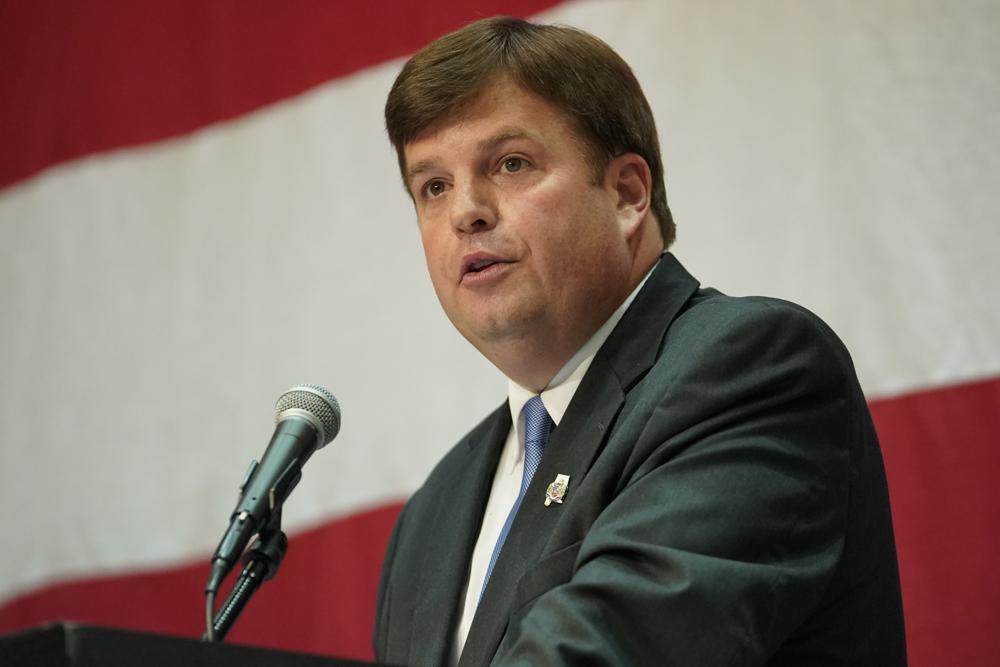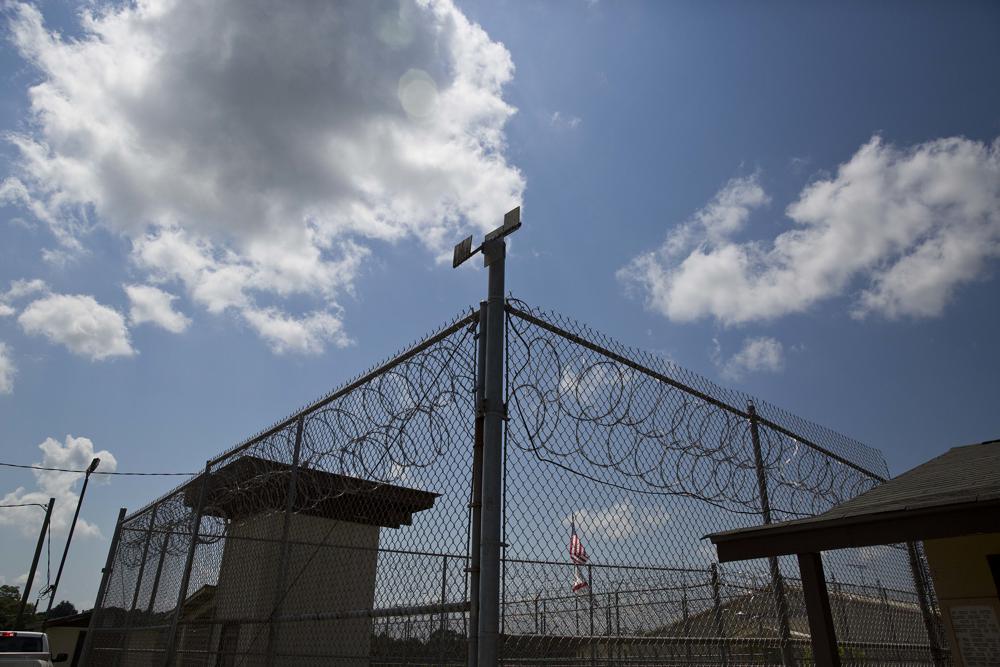Dale Strong introduces legislation to build a border wall

Congressman Dale Strong spoke on the floor of the U.S. House of Representatives to call for the Biden Administration to resume building the wall along the Southern Border with Mexico. This was the first speech that Strong has given on the floor of Congress. Rep. Strong recently traveled to the border with House Committee on Homeland Security members to see the crisis firsthand. “The Secretary of Homeland Security says that the American border is secure,” Strong said. “The American people know better.” “While heroin, fentanyl, cocaine, marijuana, and human smuggling are flowing into our country at alarming rates, America is under attack,” Strong said. “The problem is not with the laws. The problem is with this administration because they are not enforcing the laws that are on the books.” “On our visit to the border, we met with the Texas National Guard, U.S. Homeland Security, [Customs and] Border [Protection] (CBP), Immigration and Customs Enforcement, Homeland Security Investigations, and Texas State Troopers,” Strong said. “Not one of these agencies or officials could say that the U.S. border was secure. Not one.“ “During our trip, I was reminded that on his first day in office, the president terminated the emergency declaration at the southern border and halted border wall construction,” Strong stated. “Over the last two years, Customs and Border Patrol have encountered over 4.7 million illegal immigrants trying to enter our country. That doesn’t include the 1.2 million that have evaded border patrol.” Strong has recently introduced legislation to require the administration to resume work on the wall on the southern border. “My bill will resume border wall construction and ensure the president cannot withhold resources while sending our troops to the front lines.” “I am proud to introduce this legislation and other measures to ensure that if the Administration expects our troops to defend our border,” Strong stated. “Then we expect them to provide every tool, resource, and means of support to each of the brave men and women protecting our homeland security.” It has become almost standard practice for Republican members of Congress to go to the southern border and personally review the situation. U.S. Senator Katie Britt has visited the border three times since her election. “There is an unprecedented national security and humanitarian crisis at our southern border,” said Sen. Britt. “I am grateful to have this opportunity to see the problem in the Rio Grande Valley firsthand, ask tough questions, listen, and learn – so we can fight for the best possible solutions in the Senate. The number of Americans dying from fentanyl poisoning is equivalent to a commercial airplane going down in our country every single day.” The Biden administration has deemphasized border security and has halted construction of the border wall even though the contracts had already been awarded and many of the materials for the wall had already been purchased. Rep. Strong is in his first term representing Alabama’s Fifth Congressional District. To connect with the author of this story or to comment, email brandonmreporter@gmail.com.
Kay Ivey declares special session a success

Governor Kay Ivey declared the 2023 First Special Session a success on Thursday afternoon after signing both bills into law. House Bill 1 appropriated $1,060,000,000 in federal American Rescue Plan Act (ARPA) funds. “I commend the Alabama Legislature for, once again, answering the call to invest these one-time funds wisely to make improvements in Alabamians’ quality of life, including water, sewer, and broadband expansion projects, as well as health care,” Gov. Ivey said. “Alabama can now look to a future of greater promise thanks to the steps we have taken this week to invest these funds wisely.” Gov. Ivey also signed Senate Bill 2, a supplemental appropriation from the state general fund to pay off the remaining debt to the Alabama Trust Fund. “Eleven years ago, during more challenging economic times, the state made a pledge to repay $437 million borrowed from the Alabama Trust Fund in order to bolster the General Fund,” Gov. Ivey said in a statement. “Last week, I called upon the Alabama Legislature to finally pay back the remainder of these borrowed funds, noting that, unlike D.C., we pay our debts. Today, I am pleased to report that lawmakers have responded to my call by swiftly passing legislation appropriating the final $59,997,772 payment due to the Alabama Trust Fund. This is responsible stewardship of the people’s money and a fitting start to a historic Session. I am proud to sign this Act restoring the Alabama Trust Fund.” The state was forced to prorate the education trust fund (ETF) and state general fund (SGF) budgets in the fiscal year 2011 following the Great Recession of 2008 to 2010. The Legislators in 2009 and 2010 had wrongly expected a quick bounce back in the economy, so they did not make the cuts in the budgets needed to prepare state government for the new revenue realities once reserves and federal bailout funds were exhausted, resulting in a much harder budgetary hit than should otherwise have been necessary. In 2014, voters approved a plan to allow the Legislature to raid the Alabama Trust Fund (ATF). The ATF is funded by oil and gas revenues and serves as the state’s investment account. A portion of that money’s earnings is used for several purposes, including supporting the SGF. Legislators promised voters that they would pay that money back. The state took $437 million from the ATF and made annual payments to pay that back for years. SB1 takes SGF surplus dollars left over from the fiscal year 2022 to pay back the remaining $59,997,772 balance freeing up fSGF revenues for other purposes moving forward. HB1 appropriates $339,175,000 for healthcare, including $25 million for Mental health and $9 million for the expansion of telemedicine. $260 million will be used for broadband expansion, including a cybersecurity component. $395 million will go to water and sewer projects, and $55 million will be used to compensate state agencies for the negative impacts of the COVID-19 pandemic. $1,179,000 will go for administrative costs of overseeing and allocating the money. This is the second and final tranche of the ARPA money. Ivey called the special session during her state of the state address on March 7. Now that the special session is over, the 2023 Alabama Legislative Regular Session will resume on Tuesday. To connect with the author of this story or to comment, email brandonmreporter@gmail.com.
Both Auburn and Alabama advanced in NCAA basketball tournament

Thursday was a big day for college basketball fans and particularly those of Auburn University and the University of Alabama. The two big state Southeastern Conference schools won their opening round men’s basketball games before packed crowds in Birmingham’s Legacy Arena. Auburn defeated Iowa 83 to 75. Auburn’s victory was led by Sophomore Johni Broome, who had 19 points, twelve rebounds, one assist, and five blocked shots in the game. The 6’10” forward is a native of Plant City, Florida. Jaylin Williams had 11 points, two rebounds, and two assists in the win. The 6-foot-8-inch forward is a native of Mahunta, Georgia. Tre Donaldson had 11 points, three rebounds, and two assists in 13 minutes. Donaldson is a 6-foot-two-inch freshman guard from Tallahassee, Florida. Allen Flanigan had 10 points, ten rebounds, and four assists. The 6-foot 6-inch senior guard is from Littlerock, Aransas. Wendell Green Jr. had 15 points, two rebounds, and three assists. Green is a 5-foot-11-inch Guard from Detroit, Michigan. K.D. Johnson had 11 points. The 6-foot senior guard is a native of Atlanta, Georgia. Auburn will play Houston next. Auburn made the final four in 2019. Alabama defeated Texas A&M Corpus Christi 96 to 75. Nick Pringle had 19 points and fifteen rebounds. Pringle is a 6-foot-9-inch Junior forward from Seabrook, South Carolina. Mark Sears had 15 points, one rebound, and three assists. Sears is a 6-foot-1-inch Junior guard from Muscle Shoals. Jahvon Quinerly had 13 points, one rebound, and one assist. He is a 6-foot-1-inch Senior guard from Hackensack, New Jersey. Noah Clowney had 10 points and four rebounds. He is a 6-foot-10-inch Freshman forward from Spartanburg, South Carolina. Charles Bediako had 9 points and eight rebounds. Bediako is a 7-foot-10-inch Sophomore center from Bradenton, Ontario. Nimari Burnett had 11 points, three rebounds, and one assist. Burnett is a 6-foot-4-inch Sophomore guard from Chicago, Illinois. The Tide’s best player, Brandon Miller, did not score. Alabama will play Maryland next. Both teams are now in the final 32 teams. If they win, they will advance to the Sweet 16. To connect with the author of this story or to comment, email brandonmreporter@gmail.com.
Alabama lawmakers set to focus on Jobs Act and economic incentives for 2023 session

Now that the Alabama Special Session is done and ARPA funds have been allocated, leaders can focus on the 2023 regular session that begins on Tuesday. Speaker of the House Nathaniel Ledbetter explained that the Alabama Jobs Act would be one of their first priorities. “(The Alabama Jobs Act) is going to be priority No. 1 coming back after break. I think you’ll see a big push for that,” Ledbetter stated. “They’ve been very positive for our state. We’ve seen the job growth has been tremendous because of it. We’ve looked at the numbers; we got a return on the investment of 173% over a 20-year period.” Ledbetter believes legislation on this needs to be done quickly. The Alabama Jobs Act, created in 2015 and set to expire this year, has netted $256.8 million in incentives, Secretary of Commerce Greg Canfield reported in 2022. This amount outpaced the department’s benchmark of $164.6 million. The Joint Study Commission on Renewing Incentives has discussed extending the Jobs Act through 2028 with a higher payout cap. Legislation has not been filed yet. The Jobs Act created two separate incentives: The Alabama Jobs Credit and Alabama Investment Credit. The Jobs Credit gives companies cash rebates on their previous year’s payroll for qualified employees, and companies can get higher rebates if they locate in rural parts of the state or hire veterans. The Investment Credit addresses a company’s capital investment and can be applied to several taxes, including income. Companies can receive incentives for up to 10 years. The incentives are currently capped at $350 million annually . Canfield said the Jobs Act has helped the state recruit 217 projects creating more than 38,000 jobs, and he believes the $350 million cap should be increased. Canfield discussed on Twitter how rural areas have benefited from the Jobs Act as much as urban areas. “We are going to continue to build on that success,” Canfield stated. “Alabama has led the Southeast in economic development, job creation, and industrial recruitment for roughly 20 years, and much of that success is the result of the incentives we offer,” Lt. Governor Will Ainsworth told Alabama Daily News on Thursday. “If we are going to continue that incredible success for decades to come, our incentives must remain competitive with those offered by our sister southeastern states, and this proposal does just that in a conservative, common sense manner. The pay-as-you-go package we have crafted also ensures taxpayers are protected from companies that are unable to fulfill their commitments.” Other recommendations from the task force in December included: Several lawmakers agreed that focusing on the Jobs Act is a priority for the Legislature. “When we come back, the economic incentive package to me is the No. 1 priority,” Rep. Marcus Paramore stated. “I want to make sure that gets done, make sure it gets out, make sure we can continue to recruit good businesses and good high-quality jobs for our constituents.” Rep. Phillip Ensler said, “But as with any bill, I want to look at the details, and having it done in a way that is equitable and making sure that we’re doing it in a way where the numbers of it make sense.” Lawmakers will meet for three legislative days next week, Tuesday through Thursday.
Today is St. Patrick’s Day

Today is not an official holiday, so most schools, businesses, and government offices will be open. However, it is the widely celebrated St. Patrick’s Day holiday. The American celebration of St. Patrick’s Day is known for Celtic music, green clothes, parades, four-leaf clovers, lots of drinking, and all things Irish. That said, St. Patrick was a real historical person who had a massive impact on the world in which he lived. Patrick was born somewhere in Roman Britain in approximately 389 A.D. However, the location of his birth and all of the dates of his life are widely debated by historians even today. Britain was one of Rome’s last conquests as the Romans invaded the Celtic island in 43 A.D. during the reign of Emperor Claudius. Britain’s warring tribes proved to be a more complicated challenge than Rome’s emperors had anticipated, so they halted the conquest after decades of warfare in the north of the island. They pulled back near the border of what we now call Scotland and built a wall to keep the natives out. The Britons, Picts, and Gaelic-speaking Scots of the north remained outside of Rome’s control, and invading Ireland was a conquest that no emperor would ever attempt. In 313, the Co-emperors Constantine and Licinius issued the Edict of Milan, giving Christians freedom to worship. In 380, Emperor Theodosius made Christianity the Roman Empire’s official religion. By Patrick’s birth, Rome was a predominantly Christian empire. Patrick’s grandfather had been a priest, and Patrick grew up as a Christian, though not particularly devout. By the time of Patrick, the conquerors had become the hunted, and Rome was under assault from a number of directions. Roman Britain was under constant attack from Irish raiders, Picts, Scots, and the Germanic Angles, Saxons, and Jutes. In 405, the 16-year-old Patrick was captured by Irish pirates and taken to pagan Ireland as a slave. We don’t know much about the early life of Patrick, but he was well educated – particularly for the standards of the chaotic times in which he lived. In 410, the city of Rome was sacked by the Germanic Visigoths under their King Alaric. 410 was also the year Rome finally pulled its remaining forces out of Britain. The Romanized Britons were left to fend for themselves. Patrick had been tasked with tending the sheep by his master, Milchu – an Irish chieftain. During the six years Patrick was a slave in Ireland, he became increasingly devout in his faith. Patrick escaped captivity and returned to his family in Britain in approximately 411. Two years after returning home, Patrick felt the call to become a priest. In roughly 433, he returned to Ireland as a missionary determined to convert the island to Christianity. Patrick crisscrossed Ireland preaching the gospel, baptizing thousands, and ordaining numerous Irish priests. Eventually, his efforts would prove wildly successful, and a uniquely Gaelic Church took hold in Ireland. Irish missionaries would subsequently play important roles in converting the Scots, Picts, and Anglo-Saxon England. The Feast of St. Patrick is March 17 and is believed to be the day of his death. Patrick, while never formally canonized by the Catholic Church, became widely venerated as a saint, and by the Seventh Century, he was recognized as the patron saint of Ireland. Irish, fleeing English tyranny and the potato famine, brought the Feast of St. Patrick with them to America and beyond. Today the holiday has become a celebration of Ireland and Gaelic culture. To connect with the author of this story or to comment, email brandonmreporter@gmail.com.
Governors of 18 states form coalition to fight Biden administration’s ESG policy

Florida Gov. Ron DeSantis is leading a coalition of governors from 18 states who’ve pledged to fight the Biden administration’s environmental, social, and corporate governance agenda. The governors said Biden’s investment agenda is a “decision to jeopardize retirement savings for millions of Americans to promote far left priorities.” Joining DeSantis are the governors of Alabama, Alaska, Arkansas, Georgia, Idaho, Iowa, Mississippi, Missouri, Montana, Nebraska, New Hampshire, North Dakota, Oklahoma, South Dakota, Tennessee, Utah, West Virginia, and Wyoming. The coalition argues President Joe Biden’s ESG agenda is “destabilizing the American economy and the global financial system.” “At my direction, Florida has led the way in combating the pernicious effects of the ESG regime by directing our state pension fund managers to reject ESG and instead focus on obtaining the highest return on investment for Florida’s taxpayers and retirees,” DeSantis said, referring to the state last August divesting its retirement system from funds that prioritize ESG. The coalition pledged to fight against the administration’s ESG policies after 25 state attorneys general sued the administration over them in January. Many in the governors’ coalition overlap with states represented in the AG coalition. Last August, DeSantis vowed to “spearhead an initiative to join with other like-minded states to send an even louder message to the financial industry that the American people have rejected ESG at the ballot box, and ideologues cannot and should not circumnavigate the will of the people.” The governor’s coalition, he said, “delivered on that promise.” In a joint statement issued on Thursday, the governors said, “Congress exercised its powers under the Congressional Review Act” to disapprove a Department of Labor Rule, which the president has threatened to veto. In doing so, Biden has “put his political agenda above the well-being and individual freedoms of hardworking Americans.” The coalition of governors said, “… freedom loving states can work together and leverage our state pension funds to force change in how major asset managers invest the money of hardworking Americans, ensuring corporations are focused on maximizing shareholder value, rather than the proliferation of woke ideology.” The rule risks the pensions of thousands of hardworking Americans, they argue, instead of “prioritizing investment decisions on the highest rate of return.” The rule, “Prudence and Loyalty in Selecting Plan Investments and Exercising Shareholder Rights,” follows an executive order Biden issued last May. In it, he directed the federal government to implement policies “to help safeguard the financial security of America’s families, businesses and workers from climate-related financial risk that may threaten the life savings and pensions of U.S. workers and families.” The rule change “will bolster the resilience of workers’ retirement savings and pensions by removing the artificial impediments – and chilling effect on environmental, social and governance investments – caused by the prior administration’s rules,” Acting Assistant Secretary for the Employee Benefits Security Administration Ali Khawar said in a statement last fall. “A principal idea underlying the proposal is that climate change and other ESG factors can be financially material and when they are, considering them will inevitably lead to better long-term risk-adjusted returns, protecting the retirement savings of America’s workers.” The governors argue that retirees are “already suffering from the reckless fiscal policies of the Biden Administration” and are likely to “continue to experience diminished returns on the investment of their hard-earned money while the corporate elite continue to use their economic power to impose policies on the country that they could not achieve at the ballot box.” The governors have vowed to protect their residents and taxpayers by implementing several measures. These include “blocking the use of ESG in all investment decisions at the state and local level, ensuring that only financial factors are considered to maximize the return on investment, protecting retirees and taxpayers alike.” It may also include “eliminating consideration of ESG factors by state and local governments when issuing bonds or prohibiting state fund managers from considering ESG factors when investing taxpayer money.” The governors also vowed to protect citizens from ESG influences in the financial sector by “banning the financial sector from considering so-called ‘Social Credit Scores’ in banking and lending practices aimed to prevent citizens from obtaining financial services like loans, lines of credit, and bank accounts.” They’re also considering “stopping financial institutions from discriminating against customers for their religious, political, or social beliefs, such as owning a firearm, securing the border, or increasing our energy independence.” The AG’s lawsuit was filed in U.S. District Court Northern District Amarillo Division and names Secretary of Labor Martin Walsh and the U.S. Department of Labor as defendants. Republished with the permission of The Center Square.
Cost estimate on new Alabama prison jumps $300 million

An Alabama prison finance authority on Wednesday increased what the state can spend on building a new 4,000-inmate prison in Elmore County after inflation and design changes have caused cost estimates to rise, a state official said. The Alabama Corrections Institution Finance Authority voted to increase the authorized spending on the project from about $623 million to $975 million. Alabama Finance Director Bill Poole said the change was needed after inflation and design alterations increased cost projections. “Can you spell inflation?” Republican Sen. Greg Albritton, a member of the authority, said when asked about the increase. “Every construction project that we have that is ongoing is experiencing this same phenomenon.” Alabama lawmakers in 2021 approved a $1.3 billion prison construction plan that tapped $400 million from the state’s share of American Rescue Plan funds to help build two super-size prisons, including the one in Elmore County. Another prison is planned to be built in Escambia County. The move drew criticism from congressional Democrats at the time, who said the pandemic relief money was not intended to build prisons. The prison in Elmore County will house at least 4,000 inmates and offer space for medical and mental health care treatment. Alabama officials last year signed a $623 million contract with Caddell Construction Co. for the construction. Poole said that the initial cost estimate was “based on very early design.” “We’ve increased, for instance, the education and vocational space. There have been other scope and parameters that have changed. Inflation has had a significant impact on construction costs, as is seen across all economic sectors,” Poole said. He said the state should have a final price this summer. Albritton said he believes the construction project is the best option for the state despite the increase in cost. “The prisons that we’ve got are falling apart. We’ve got to do something. It’s better to execute the plan that we’ve got than try to start over,” Albritton said. The prison construction plan has been criticized by some members of the Alabama Legislature. Alabama lawmakers are meeting in a special session to decide how to use the remainder of money the state received from the American Rescue Plan. Democratic Rep. Juandalynn Givan said during debate Tuesday that the state has many needs that could be helped by the relief dollars, but lawmakers instead spent hundreds of millions of dollars for “prisons that we haven’t built yet.” Republished with the permission of The Associated Press.
Lawmakers say prison plan will continue despite cost jump

Alabama legislative leaders said Thursday they will proceed with plans to build two super-size prisons, despite the cost estimate for the first one mushrooming to nearly $1 billion. The Alabama Corrections Institution Finance Authority on Wednesday increased the spending cap for the 4,000-bed prison in Elmore County, from $623 million to $975 million. Alabama Finance Director Bill Poole said the change was needed after inflation and design alterations caused the projected cost to rise. “I wish it wasn’t there, but as all of you know, inflation has hit us pretty hard over the last few months, and that’s certainly a reflection of that,” House Speaker Nathaniel Ledbetter told reporters. Asked if the state will be able to build both prisons, Ledbetter said he thinks the state will go forward with the plan. “I mean, there might be some adjustments along the way, but as all of you know, we’ve got to do something,” Ledbetter said in reference to the state’s ongoing prison crisis. Republican Rep. Rex Reynolds, the chairman of the House general fund committee, said he had been warned recently that the increase would be needed. “That’s tough. We didn’t see that coming when we first voted on the bond money,” Reynolds said. Still, the move drew criticism from some Democrats. “Actual prison construction hasn’t even started yet, but we are already up to a billion dollars. We haven’t even started talking about paying for the second prison yet. Add this to the billion dollars we are spending on a prison healthcare contract. This is not sustainable,” Democratic Rep. Chris England wrote in a tweet. Alabama lawmakers in 2021 approved a $1.3 billion prison construction plan that tapped $400 million from the state’s share of federal pandemic relief dollars to help build two super-size prisons, including the one in Elmore County and a second one in Escambia County. The U.S. Department of Justice has an ongoing lawsuit against Alabama, accusing the state of violating the constitutional rights of male prisoners in a system “riddled with prisoner-on-prisoner and guard-on-prisoner violence.” The Justice Department noted in an earlier report that dilapidated facilities were a contributing factor to the unconstitutional conditions but wrote, “new facilities alone will not resolve” the matter because of problems with management deficiencies, corruption, violence, and other issues. Republished with the permission of The Associated Press.


